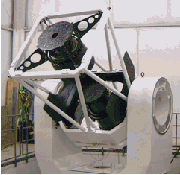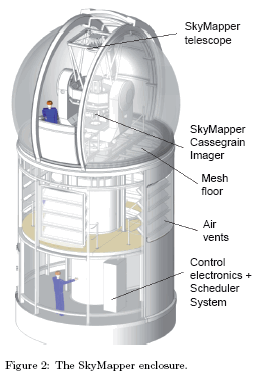|
News & Views item - December 2007 |
![]() ANU'S
SkyMapper Nears Scientific Productivity. (December 4, 2007)
ANU'S
SkyMapper Nears Scientific Productivity. (December 4, 2007)
 In
a sense it's a phoenix risen from the ashes of the bushfires that
engulfed Mt Stromlo nearly four-years ago. A 1.35 Meter (53 inch)
reflecting telescope which has been funded with insurance funds,
government contributions and private donations and was designed at the
Research School of Astronomy and Astrophysics of the Australian National
University. It "has risen from the distruction" of the Great Melbourne
Telescope, destroyed on January 18, 2003.
In
a sense it's a phoenix risen from the ashes of the bushfires that
engulfed Mt Stromlo nearly four-years ago. A 1.35 Meter (53 inch)
reflecting telescope which has been funded with insurance funds,
government contributions and private donations and was designed at the
Research School of Astronomy and Astrophysics of the Australian National
University. It "has risen from the distruction" of the Great Melbourne
Telescope, destroyed on January 18, 2003.
The telescope which will be fully automated is sited at the Siding Spring Observatory in New South Wales, and is scheduled to go online toward the middle of 2008.
 The
SkyMapper telescope is designed to carry out the Stromlo Southern Sky
Survey (S3), a multi-colour, multi-epoch survey of the southern sky. S3
will be analogous to the Sloan Digital Sky Survey in the North
hemisphere but with a number enhancements, including temporal coverage,
more precise measurements of stellar properties and coverage of large
part of the Galactic Plane.
The
SkyMapper telescope is designed to carry out the Stromlo Southern Sky
Survey (S3), a multi-colour, multi-epoch survey of the southern sky. S3
will be analogous to the Sloan Digital Sky Survey in the North
hemisphere but with a number enhancements, including temporal coverage,
more precise measurements of stellar properties and coverage of large
part of the Galactic Plane.
The telescope's CCD device consists of a 268-million pixel Cassegrain Imager with a 5.7 square degree field of view.
According to ANU's RSAA: "SkyMapper will be among the first of a new breed of surveying telescopes which are able to scan the night-time skies more quickly and deeper than ever before. The SkyMapper telescope will provide a deep digital map of the southern sky which will allow astronomers to study everything from nearby objects such as asteroids in our solar system to the most distant objects in the universe called quasars. The data taken by the SkyMapper telescope will be shared with astronomers around the world via the Virtual Observatory initiative, so that every possible use can be made of this resource."
The survey will take five years to map the southern sky and when finished will have created Australia's largest non-proprietary data set of half a petabyte (500,000,000,000,000 bytes — 5x1014) of astronomical information.
Everything south of the celestial equator will be imaged in six filters,
with each filter having six exposures allowing astronomers to build a
map of what the sky looks like in different colours, as well as seeing
how it changes over time.
"In that dataset we can extract those extremely rare but very important objects that have eluded us thus far, that give us important constraints on the typical parameters of the universe," the RSAA's Stefan Kellar told Computer World. "We've designed our filter set to have optimal ability to decode those stars. It's a whole new window into the construction of the galaxy."
And RSAA has promised that this information base will be made widely available, free of charge, to anyone who wants it. "We have so much data that in order to make the best of use it we have to let the rest of the world do great science with it as well as ourselves, so we will share it via the Web in the order of 30 terabytes," Kellar said.